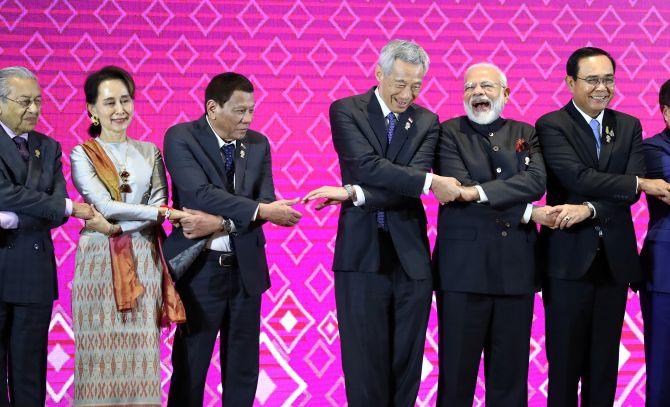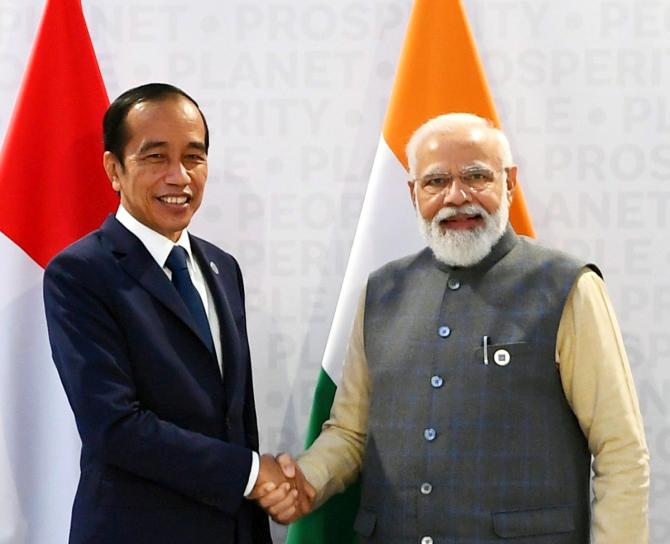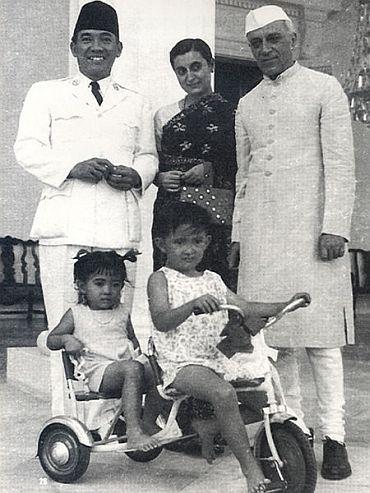The Modi government has to embrace the history of Tamil conquests in South East Asia and stop obsessing about Babar/Humayun, argues Colonel Anil A Athale (retd).

The Modi government can take justifiable pride in the fact that in the last 8 years it has succeeded in navigating choppy international waters with dexterity and enhanced India's power and prestige.
I have deliberately used the term 'Modi government' as opposed to the BJP or NDA government as the prime minister has largely been responsible to lend dynamism to India's external relations.
Since he takes the credit for successes, he must also take the responsibility for lack of achievements.
This is most glaring in the case of India's relations with South East Asia.
Many of us have become old hearing the oft-repeated phrase 'India must look East' ad nauseum, yet on the ground, India's economic, cultural and security relations with South East Asia remain stagnant. Part of the reason for this is structural.
India, the world's fifth biggest economy and having the world's third biggest military, has one of the tiniest foreign services.
The Indian Foreign Service has resisted all calls for expansion and remains elitist and devoid of domain experts (economists, technologists, military) and instead remains largely generalist dominated.
There is indeed territorial division at the joint secretary level (the various regional desks), but not at the higher level. It is about time that India created geographic divisions like Europe and America, Africa, Central and West Asia, South East Asia and Pacific and South Asia and have secretary-level officers heading each division and a minister of state for each division.
In addition, the foreign ministry must also create a separate department of military relations that must deal with the issues of disarmament and military aid.
Each territorial division must also have a military and economic expert as part and parcel of the new organisation.
In this respect, it is worthwhile to study the American state department to copy relevant structures.
As someone who has dealt with the US for the last 30 odd years, I can vouch for the fact that it is indeed a well-crafted orgnisation compared to our colonial era outfit.
Obviously, these are just tentative suggestions and a detailed study would be needed, but suffice it to say that without this acceptance and implementation of the expansion and re-organisation of the foreign ministry, India's foreign policy will remain sub-optimal.
The principal challenge for the foreign minister would be to coordinate all this work as well as offer leadership in crucial areas.
A crisis like the Ukraine war would not be handled by the Europe division, but by the minister himself!

India's foreign policy has also been lacking in the cultural dimension.
Many of us had high hopes in 2014 when a party proud of and sensitive to Indian heritage came to power.
Undoubtedly, much work is being done on the Buddhism front.
It was expected that re-establishing Hindu cultural links with South East Asia, that has Indian culture as a dominant influence, would be the first priority. But leave alone any new initiative, even the Pallava script stone tablet in the Jakarta museum remains without translation even 8 years after Modi came to power.
The Indian Council of Cultural Relations, a crucial body under the foreign ministry, remains stuck in Nehruvian slumber as far as South East Asia is concerned.
Indian influence in South East Asia is more because of Indian films rather than any government efforts.
Instead of working in tandem with Bollywood, minions of the Modi government have been busy hounding talent that is perceived to be ideologically different.
India's lackadaisical approach to relations with Indonesia is a case in point.
No country in the world is closer to India culturally than Muslim majority Indonesia.
The world's largest Buddhist stupa at Borobudur as well as some of the world's tallest Hindu temples at Prambanan are both in Indonesia.
While a secularist in India may shudder to think of putting up a Gita Upadesh monument on Rajpath in Delhi, Indonesia has one in Merdeka Square in Jakarta, just outside the presidential palace.
Why, the Indonesian air force special forces's motto is Karmanyewadhi Karasthe, Ma Faleshu Kadachina from the Bhagavat Gita.
At random and remote places like Berau in the north of Kalimanthan (Borneo) island, one finds Hindu temples with the Gayatri Mantra!
Indonesia is the largest and potentially the strongest country in ASEAN. In India's looming confrontation with China in the Indo-Pacific, it can be a crucial ally that can choke Chinese sea lanes.
I have travelled extensively in South East Asia (Indonesia, Vietnam, Laos, Cambodia and Thailand) and can vouch for the fact that there is nothing but goodwill for Indians in all these countries.
Conversely, there is both suspicion and resentment against the Chinese who dominate much of the trade and commerce.
These countries would dearly love to be closer to India economically and militarily, to balance the Chinese influence that is feared.

IMAGE: Sukarno with son Guntur Sukarnoputra and daughter Megawati Sukarnoputri with Jawaharlal Nehru and his daughter Indira Gandhi.
Photograph: Presidential Documents, National Library of Indonesia.
In the heydays of the non-alignment movement, Nehru and Indonesia's Sukarno were initially very close.
Sukarno's daughter Megawati (who was to become president in the 21st century) was named by Biju Patnaik, later the Orissa chief minister and a pilot who had rescued Sukarno and his family from the clutches of the Dutch colonialists.
But relations began to sour when Sukarno felt that Nehru appropriated the credit for 'Panchsheel' or five principles as the foundation for Afro Asian relations when it was proposed by Sukarno and is a part of Indonesian history.
Even the 'unity in diversity' motto claimed by Nehru as his was actually a policy of the Mjapahit Hindu kings of Indonesia coined in the 12th century. It is also a national motto of Indonesia.
India and Indonesia drifted apart when in 1960 during the Sarawak-Sabah crisis over British Borneo, India sided with Malaya.
The position of Sarawak/Sabah was somewhat analogous to Kashmir. Indonesia expected India's support, but never got it. Not only that, but India provided military assistance to Malaya.
Part of the reason for the Indian stand was that Malaya had a large Indian origin population and Nehru was mindful of it.
Malaya remained grateful to India for this and was the only country to support us in 1962 against China. But the Malayan support did not last long and since then it has been a staunch supporter of Pakistan.
Sukarno, incensed by Nehru's betrayal on the Sarawak issue, paid India back in the same coin by supporting Pakistan in the 1965 War.
Subsequent to Sukarno's overthrow by the pro-West Suharto and his long 30 year rule saw balanced relations between India and Indonesia.
During his tenure, the far seeing Atal Bihari Vajpayee paid special attention to Indonesia and relations did see an upswing. But Manmohan Singh's tenure as prime minister meant the return of Nehruvian neglect of South East Asia, totally ignoring the cultural dimension.
The return of the BJP in 2014 and again in 2019 has made little difference; relations with Indonesia continue to be neglected.
The ruling dispensation's obsession with the North Indian cow belt for electoral purposes has meant that India's Tamil heritage in South East Asia is all but forgotten.
At the hands of IFS bureaucrats, Indonesia has returned to the policy of benign neglect of Nehruvian era.
It will be interesting to watch if the Modi government wakes up to the potential of India's cultural influence in South East Asia in its remaining two years of its rule.
To do this, it will have to shed the cow belt obsession with India's past and embrace Tamil heroes like Raja Rajendra Chola.
It has to begin with embracing the history of Tamil conquests in South East Asia and stop obsessing about Babar/Humayun.
A beginning has to be made by creating a pan India ICCR with a second headquarters in Chennai.
Even Delhi centric cultural dens like the Indian Council of Historical Research and other social sciences and central universities like Delhi University or JNU must begin to have Southern, Eastern and Western campuses.
The Modi government must realise there is more to India than Delhi or Gujarat!
Colonel Anil A Athale is a military historian whose earlier columns can be read here.
Feature Presentation: Rajesh Alva/Rediff.com










